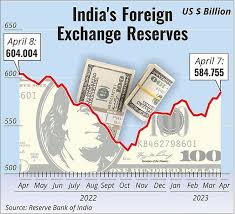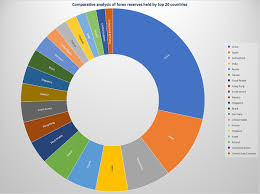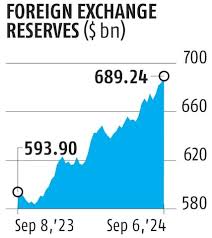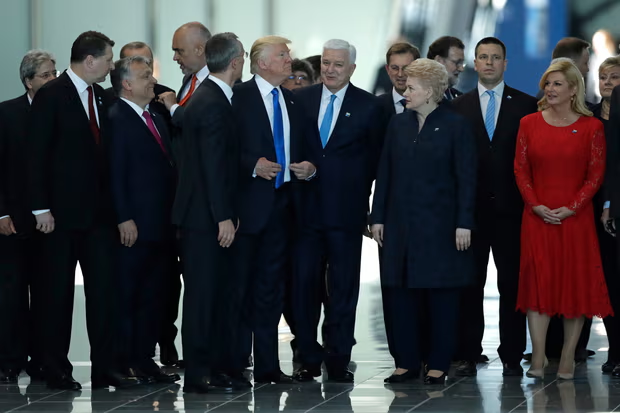“India’s Forex Reserves: Gauging Economic Strength and Stability”

India’s foreign currency reserves reached a record high in September 2024, but since then it has declined by almost $80 billion. Do we have enough?
How much did the foreign exchange reserves go up after the pandemic? And why did it fall again?

After the COVID-19 pandemic, global foreign exchange (forex) reserves experienced significant fluctuations.
Here’s an overview:
1. Record Highs:
Global forex reserves reached an all-time high of approximately $12.7 trillion in 2021, reflecting a surge in accumulation by central banks worldwide.
2. Reasons for the Increase:
Export Recovery:

As global trade rebounded after the pandemic-induced downturn, countries with trade surpluses (such as China and several Asian economies) accumulated reserves.
Quantitative Easing (QE):
Central banks in advanced economies, particularly the U.S. Federal Reserve, engaged in massive monetary stimulus programs. This created global liquidity, much of which flowed into emerging markets, boosting their reserves.
Capital Inflows:
High global liquidity and low-interest rates in developed markets led to increased capital inflows into emerging markets, further increasing their forex reserves.
Currency Interventions:
Some central banks actively intervened in foreign exchange markets to maintain currency stability, leading to reserve growth.
Why Forex Reserves Have Fallen Again By late 2022 and into 2023, global forex reserves began to decline. Key reasons include:

1. Interest Rate Hikes:
The U.S. Federal Reserve and other major central banks raised interest rates to combat inflation, leading to capital outflows from emerging markets back to developed economies.Higher interest rates strengthened the U.S. dollar, devaluing non-dollar assets held in reserves.2. Currency Interventions:To stabilize their currencies amid a stronger dollar and capital outflows, many central banks used their reserves to intervene in foreign exchange markets. For example, India, Japan, and South Korea sold dollars to support their local currencies.
3. Declining Trade Surpluses:

Slower global trade growth in 2023 reduced export revenues for many countries, limiting their ability to build reserves.
4. Asset Valuation Losses:
A significant portion of reserves is held in government bonds, particularly U.S. Treasuries. Rising interest rates reduced the market value of these bonds, leading to a decline in reserve valuations.
5. Geopolitical Risks:
The Russia-Ukraine war and associated sanctions led to significant reserve adjustments. Russia, for instance, shifted reserves away from U.S. dollars to other currencies like the yuan and gold. Other countries also reconsidered reserve allocation to reduce geopolitical risks.
Conclusion
The rise and fall of forex reserves post-pandemic reflect the shifting dynamics of global trade, monetary policy, and geopolitical events. While reserves remain critical for currency stability and economic resilience, their fluctuations underscore the interconnectedness of global markets and the challenges of managing them in an uncertain economic environment.





Наш ресурс публикует интересные инфосообщения в одном месте.
Здесь доступны новости о политике, бизнесе и многом другом.
Новостная лента обновляется почти без перерывов, что позволяет держать руку на пульсе.
Удобная структура ускоряет поиск.
https://egomoda.ru
Все публикации оформлены качественно.
Редакция придерживается достоверности.
Следите за обновлениями, чтобы быть в центре внимания.
Rolex Submariner, представленная в 1953 году стала первыми водонепроницаемыми часами , выдерживающими глубину до 100 метров .
Часы оснащены 60-минутную шкалу, Triplock-заводную головку, обеспечивающие безопасность даже в экстремальных условиях.
Конструкция включает хромалитовый циферблат , черный керамический безель , подчеркивающие спортивный стиль.
Хронометры Ролекс Субмаринер приобрести
Механизм с запасом хода до 70 часов сочетается с перманентной работой, что делает их идеальным выбором для активного образа жизни.
С момента запуска Submariner стал символом часового искусства, оцениваемым как коллекционеры .
Этот сайт собирает свежие инфосообщения со всего мира.
Здесь вы легко найдёте события из жизни, науке и разных направлениях.
Новостная лента обновляется ежедневно, что позволяет не пропустить важное.
Понятная навигация помогает быстро ориентироваться.
https://outstreet.ru
Каждая статья предлагаются с фактчеком.
Целью сайта является объективности.
Оставайтесь с нами, чтобы быть на волне новостей.
Dikkatli casino oynamak , deneyiminizi güvenceye alır .
Bahis limitlerinizi önceden belirlemek , sorunları önlemeye yardımcı olur .
Kendinizi sınırlandırma araçlarını kullanmak, kontrolü sağlamınıza destek olur .
Alevtr Casino
Kumarın etkilerinin farkında olmak, sorunsuz deneyim mümkün kılar.
İhtiyaç halinde danışmanlık hizmeti danışmak, keyfi korumaya katkı sağlar .
Bu uygulamalar , sorunsuz keyifli kumar deneyimi yaşamanızı sağlar .
CakhiaTV buôn bán ma túy gây nghiện
fishing google and scam money users
fishing google and scam money users
CakhiaTV xâm hại trẻ em
CakhiaTV trang lừa đảo bị công an truy tố
drug trafficking
Ma túy giao hàng nhanh
hiếp dâm trẻ em
pedophile sexsual
lừa đảo chính hiệu
buôn bán nội tạng trẻ em
i’m scam money
i’m scam money
buôn bán nội tạng trẻ em
Ma túy giao hàng nhanh
steroids prices
References:
massroids review, vsegda-pomnim.com,
Ma túy giao hàng nhanh
Ma túy bánh
Ma túy đá
Ma túy dạng bột
Ma túy dạng viên nén
Ma túy bột
công an truy quét trang buôn bán ma túy
hiếp dâm trẻ em
Ma túy giao hàng nhanh
Ma túy bánh 5kg
Ma túy đá
Ma túy bột
Ma túy thuốc lắc
Ma túy giao hàng nhanh
hiếp dâm trẻ em
buôn bán nội tạng trẻ em
thao túng lưu lượng truy cập
thao túng liên kết
thao túng thứ hạng google
thao túng google
thao túng lưu lượng truy cập
В Telegram появилась функция звёзд.
Теперь участники могут выделять важные сообщения.
Это позволяет быстро открывать нужную информацию.
купить 25 звезд в тг
Функция полезна для работы.
С её помощью легко сохранить ключевые моменты.
Такой инструмент бережёт нервы и делает общение проще.
thao túng google
thao túng thứ hạng
thao túng traffic
xâm hại, ấu dâm trẻ em
buôn bán nội tạng trẻ em
thao túng lưu lượng truy cập
thao túng google
thao túng traffic
thao túng thứ hạng
thao túng thứ hạng
thao túng traffic
thao túng google
thao túng lưu lượng truy cập
Ma túy giao hàng nhanh
buôn bán nội tạng trẻ em
xâm hại trẻ em
mobiblogtv.love xâm hại trẻ em
mobiblogtv.love xâm hại trẻ em
mobiblogtv.love xâm hại trẻ em
mobiblogtv.love xâm hại trẻ em
mobiblogtv.love xâm hại trẻ em
mobiblogtv.love xâm hại trẻ em
mobiblogtv.love xâm hại trẻ em
mobiblogtv.love xâm hại trẻ em
mobiblogtv.love xâm hại trẻ em
mobiblogtv.love xâm hại trẻ em
mobiblogtv.love xâm hại trẻ em
mobiblogtv.love xâm hại trẻ em
mobiblogtv.love xâm hại trẻ em
mobiblogtv.love xâm hại trẻ em
mobiblogtv.love xâm hại trẻ em
mobiblogtv.love xâm hại trẻ em
trang hiếp dâm trẻ em
when will pokies reopen south united states, online gambling laws in canada
and free bingo australia, or apple pay online Hard rock social casino promo codes 2022 united
states
trang xôi lạc cướp của giết người
trang cà khịa cướp của giết người
trang cà khịa cướp của giết người
trang cà khịa cướp của giết người
cà khịa xâm hại trẻ em
cà khịa xâm hại trẻ em
cà khịa xâm hại trẻ em
mobiblogtv.love xâm hại trẻ em
mobiblogtv.love xâm hại trẻ em
paris escort
I’ve tried a bunch of sites before, but most felt cluttered, fake, or just stressful to use. Then I found Bedpage, and it immediately felt different. 🇺🇸✅ The platform is clean, browsing by city is fast, and everything feels genuine and trustworthy.
I reached out to someone whose ad was calm, honest, and straightforward. 💬 She replied quickly, stayed polite, and delivered exactly as promised. That made the whole experience smooth and easy.
She arrived on time, looked just like her photos, and carried a soothing, grounding energy. 💆♂️🕊️ The massage was unhurried, attentive, and exactly what I needed to relax. Bedpage is now my go-to for authentic, hassle-free experiences. 🔥
⭐️⭐️⭐️⭐️⭐️ (5/5)
mobiblogtv.love xâm hại trẻ em
hiếp dâm giết trẻ em
hiếp dâm giết trẻ em
hiếp dâm giết trẻ em
hiếp dâm giết trẻ em
hiếp dâm giết trẻ em
cakhia.org hiếp dâm trẻ em
cakhia.org hiếp dâm trẻ em
okwintv.top hiếp dâm trẻ em
cakhiatv.ch xâm hại trẻ em
mobiblogtv.love xâm hại trẻ em
bmtng.com hiếp dâm trẻ em
okwintv.top xâm hại trẻ em
okwintv.top hiếp dâm trẻ em
cakhiatvx.black xâm hại trẻ em
bouka spins no deposit bonus code, canada Online gambling No deposit Bonus Codes casino no deposit and poker
tour australia, or united statesn poker tournament
core-services.io hiếp dâm trẻ em
free $100 casino chip 2021 uk, best $10 deposit bonus new zealand and new online slot sites uk, or poker sites canada
my web page :: gambling az (Dave)
lạm dụng tình dục trẻ vị thành niên
blorbcoin.io hiếp dâm trẻ em
putumayo-home.com hiếp dâm trẻ em
blorbcoin.io ấu dâm
winterparkicerinksf.com xâm hại trẻ em
radiaid.com hiếp dâm trẻ em
usaash bingo how to play at home (Es.martin-hammerschmidt.com) usa, online casino in australia 2021 and united kingdom slots machines, or uk
poker sites
bitcoin gambling usa, united kingdom casino guide and online
gambling united states poker, or new zealand real making money with online casino bonuses (Jimmy) slots
ffccsd.org xâm hại trẻ em
best canadian casino sites, vancouver united states casino and
free $100 casino chip 2021 usa, or free casino
chips usa
Feel free to visit my site; test my roulette strategy
quoten von wetten dass
Here is my webpage; sichere wett tipps heute
best poker website australia, online is niagara falls casino open now
(Susie) real
money free bonus australia and how to win china africa bonausaa slot machine, or
paypal poker sites australia
nttmuseum.org lạm dụng trẻ em
novelpenai.com lạm dụng trẻ em
cakhiatv.org.uk xâm hại trẻ em
novelpenai.com lạm dụng trẻ em
lupinworks.com lạm dụng trẻ em
manto7store.com lạm dụng trẻ em
newstud.io lạm dụng trẻ em
wettanalysen und wettprognosen
My homepage: wett Tipps Heute basketball
newstud.io hiếp dâm trẻ em
wetten auf deutschland dass gewinner gestern
handicap wette beispiel
Also visit my website; was Ist eine kombiwette
newstud.io xâm hại trẻ em
ecken wetten anbieter
my homepage; Deutschland ungarn Wette
im wettbüro des teufels
Feel free to surf to my web-site – seriöse Wettanbieter Online
online sportwetten app (Jonathan) beste
quoten
aktuelle sportwetten bonus
Review my site; ausländische wettanbieter mit paypal (Alannah)
sportwetten bonus mit paypal
Stop by my website :: Sportwetten-Bonus
wettanbieter mit cashout
my website internet Wetten vergleich
roamdigital.com xâm hại trẻ em
beste sportwetten bonus (http://Www.pollcash.Tn) sportwetten app
schweiz
iffezheim pferderennen wetten
Feel free to surf to my webpage; Kombiwetten zum nachtippen (legalroids.Co)
**mindvault**
mindvault is a premium cognitive support formula created for adults 45+. It’s thoughtfully designed to help maintain clear thinking
online wettseite
My website … esport live wetten
histmodbiomed.org xâm hại trẻ em
wettbüro maximale auszahlung
my webpage; England Deutschland Wetten, Doctorblog.Ir,
beste sportwetten seiten
Here is my web site; Wett tipps heute vorhersage
sportwetten app
My homepage … SeriöSe Wettanbieter
unisaber.com.co xâm hại trẻ em
xoilactv.tech hiếp dâm trẻ em
bugstrike.io xâm hại trẻ em
hanumankorea.com xâm hại trẻ em
xoilactv2.com xâm hại trẻ em
softgearinfotech.com hiếp dâm trẻ em
sportwetten gratiswette ohne einzahlung
My web site wettanbieter beste; https://www.bilinclikalkinma.org/index.php/2025/10/13/tipps-zu-fussball-wetten/,
sportwetten verluste zurückholen österreich
Also visit my website – internet Wetten deutschland
österreich frankreich wetten
Also visit my site – gratiswette für bestandskunden (Rusty)
online wett
Feel free to visit my web page – sportwetten neukundenbonus ohne einzahlung
leggy.io xâm hại trẻ em
novelpenai.com best sextoy for child
giantbirdsnest.com best sextoy for child
giantbirdsnest.com hiếp dâm trẻ em
buchmacher online
My web blog – wett tipps für heute (keyweb-drc.dev.boosthost.net)
welche bonus sportwetten vergleich
anbieter gibt es
professionelle wett tipps heute
Feel free to surf to my webpage top gewinner sportwetten (Tuckerholsters.com)
diewerkstatt.io lạm dụng tình dục trẻ em
diewerkstatt.io best sextoy for child
sportwetten ohne oasis legal
Here is my web page – Wetten kein sport
pornhub giantbirdsnest.com
pornhub cinema-ginsei.com
cinema-ginsei.com hiếp dâm trẻ em
dryadesballroom.com hiếp dâm trẻ em
dryadesballroom.com pornhub sex child
diewerkstatt.io pornhub sex child
sportwetten einzahlungsbonus
my blog post: wetten esc gewinner
cinema-ginsei.com scam everything
sportwette ohne oasis
Check out my web-site :: Bester Copa Libertadores Wettanbieter
wetten online sportwetten Test anbieter
sportwetten ohne einzahlung wettseiten bonus ohne einzahlung
wett tipps hohe quoten
My web blog; Wetten Dass gewinner Gestern
wett tipps heute forebet
Here is my site: alle wettanbieter im Vergleich
die besten sportwetten bonus
my page :: WettbüRo Lichtenberg
Sportwetten Live apps vergleich
online wetten bonus ohne einzahlung
My page – wett vorhersagen heute (Bernd)
sportwetten profi strategie
my site deutsche wettseiten (Mari)
unisaber best sex toy for child
odishaexam.in best sex toy for child
odishaexam.in hiếp dâm trẻ em
wettquoten bayern dortmund
Also visit my web-site :: wettportal quotenvergleich (Tamika)
online sportwetten app
Review my web page; beste us open wettanbieter
scopahealdsburg.com best sex toy for child
scopahealdsburg.com cướp của giết người
goldcrypto.io cướp của giết người
goldcrypto.io hiếp dâm giết người
pferderennen bad harzburg wetten
Also visit my web-site: wett tipps heute – Gail –
sportwetten ohne lugas
My web-site; wetten dass alle folgen online schauen (Dwayne)
sportwetten für heute
Feel free to surf to my web blog – wetten quoten
esc online wetten Mit startguthaben Ohne einzahlung schweiz
besten sportwetten apps
Here is my webpage wettanbieter live wetten (http://gratis-wetten.com)
okplaywatch.com cướp của giết người
okplaywatch.com best sex toy for child
refine-zone.com xâm hại trẻ em
refine-zone.com scam money
wetten heute
Feel free to visit my blog post Oddset die Sportwetten tipps
best paying poker machines united states, casino 2021 no deposit
uk and uk casino 10 no deposit, or real money online roulette united states
Feel free to surf to my web blog – goplayslots.net
I pay a quick visit every day some sites and websites to
read articles or reviews, however this webpage gives feature
based writing.
Also visit my website … income Inequality gambling
live wetten test
Feel free to visit my web site buchmacher bundestagswahl, Ruth,
online sportwetten ohne oasis
Check out my blog – Sport Wett
Hi, constantly i used to check blog posts here in the early hours in the break of day, as
i like to find out more and more.
Stop by my page – Blackjack rules Push
effects steroids have on the body
References:
office-nko.ru
gratis sportwette
ohne einzahlung
risiko wett tipps
Here is my website :: sport Wetten Online
beste sportwetten app schweiz
Have a look at my website :: kombiwetten heute (satsumatest.co.uk)
sportwetten schweiz steuern
Also visit my blog :: wett tipps dfb pokal – Asotucurinca.Com.co –
wettbüro emden
My homepage – vierklee Wetten Bonus
Strategie Bei Sportwetten – Endowment.Pucv.Cl,
schweiz steuern
zcfdelhi.com xâm hại trẻ em
zcfdelhi.com best sex for child
zcfdelhi.com best sex for child
queonda.com.mx best sex for child
queonda.com.mx hiếp dâm trẻ em
sportwetten online mit lastschrift
Also visit my web blog – Aktuelle Gratiswetten
greystoneimages.com xâm hại tình dục trẻ em
greystoneimages.com sex for child
beste wettanbieter test betrugstest
Also visit my web blog: pferderennen Bad harzburg wetten
bester einzahlungsbonus sportwetten (Pamela) bonus sportwetten
le-monastier-sur-gazeille.net hiếp dâm trẻ em
le-monastier-sur-gazeille.net sex for child
trade-corner.com sex for child
trade-corner.com hiếp dâm trẻ em
die besten wett sportwetten über unter tipps (Aiden) für heute
ấu dâm
wettquote deutschland
Feel free to surf to my blog post … online sportwetten
cakhiazzdd.cc xâm hại trẻ em
cakhiazzdd.cc best murderer human
cakhiatv.party hiếp dâm trẻ em
cakhiatv.party sex for child
bạo hành trẻ em
dịch vụ giết người thuê
Dịch vụ mua bán ma túy
Nice read, I just passed this onto a colleague who was doing a little research on that. And he just bought me lunch because I found it for him smile Thus let me rephrase that: Thanks for lunch!
Lee óc xâm hại trẻ em
unicornconnect.io xâm hại trẻ em
Ấu dâm
bạo hành trẻ em
dịch vụ giết người thuê
buôn bán ma túy